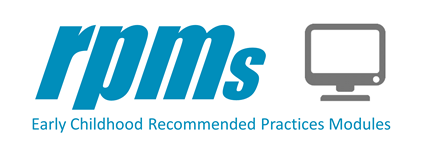Module 1: Interaction
Welcome to this Module on Interaction based on the Division for Early Childhood (DEC) Recommended Practices. This module will help you learn to support children’s learning and development through quality adult-child and child-child interactions.
Learning Objectives
Completion of this module will enable you to:
- Explain what is meant by sensitive and responsive interactions to support children’s development in language, cognitive and emotional competence.
- Observe, interpret and respond contingently to support children’s learning and development in language, cognitive and emotional competence.
Each module developed by the Recommended Practices Module (RPM) project introduces and illustrates the practices grouped in one of the eight topic areas in the Division for Early Childhood (DEC) Recommended Practices. The DEC Recommended Practices were developed to provide guidance about the most effective ways to improve the learning outcomes and promote the development of young children, birth through five years of age, who have or are at-risk for developmental delays or disabilities.
Introduction to the RPM Crosswalks
Module 1 is aligned to the topic area of interaction and focuses on the following recommended practices:
Recommended Practices
- INT1. Practitioners promote the child’s social-emotional development by observing, interpreting, and responding contingently to the range of the child’s emotional expressions.
- INT2. Practitioners promote the child’s social development by encouraging the child to initiate or sustain positive interactions with other children and adults during routines and activities through modeling, teaching, feedback, or other types of guided support.
- INT3. Practitioners promote the child’s communication development by observing, interpreting, responding contingently, and providing natural consequences for the child's verbal and non-verbal communication and by using language to label and expand on the child’s requests, needs, preferences, or interests.
- INT4. Practitioners promote the child’s cognitive development by observing, interpreting, and responding intentionally to the child's exploration, play, and social activity by joining in and expanding on the child's focus, actions, and intent.
- INT5. Practitioners promote the child’s problem-solving behavior by observing, interpreting, and scaffolding in response to the child’s growing level of autonomy and self-regulation.
